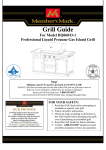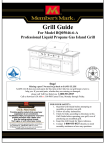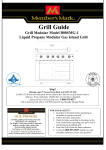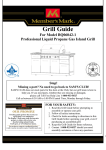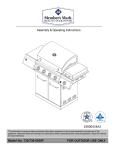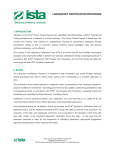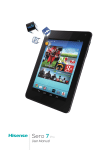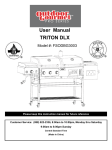Download Owner`s Manual (General)
Transcript
Grill Guide For Model BQ05051-3 LP Gas Barbecue Grill STOP! Missing A Part? No Need To Go Back To The Store! The store where you made the purchase does not stock parts for this item. If you need parts, whether they are missing or damaged, please call our Toll Free Help Line 1-800-933-0527. Call us between 8:30 AM and 5:00 PM Central Time, Monday through Friday. FOR YOUR SAFETY: 1. Read this Grill Guide before attempting to assemble or operate your grill. 2. Follow all safety instructions. 3. Check for leaks according to directions in this Grill Guide before operating your grill, even if purchasing an assembled grill. 4. Keep this Grill Guide for future reference. 5. Contact 1-800-933-0527 should you need assembly assistance or have any questions. THIS GRILL IS FOR OUTDOOR USE ONLY. If stored indoors, then detach and leave propane cylinder outside. 1 TO THE INSTALLER OR PERSON ASSEMBLYING THIS GRILL: Leave this Grill Guide with the consumer. TO THE CONSUMER: Retain this Grill Guide for future reference. Safety Precautions Always read and follow all DANGER, WARNING, AND FOR YOUR SAFETY notices in this Grill Guide. Failure to do may result in serious bodily injury or death, or in a fire or an explosion causing damage to property. 1. Grill installation must conform with local codes or, in the absence of local codes, with either the National Fuel Gas Code, ANSI Z223.1/NFPA 54, Natural Gas and Propane Installation Code, CSA B149.1, or Propane Storage and Handling Code, B149.2. 2. This gas grill, when installed, must be electrically grounded in accordance with local codes or , in the absence of local codes, with the National Electrical Code, ANSI/NFPA 70, or the Canadian Electrical Code, CSA C22.1. This applies if an external electrical source is utilized. 3. This gas grill shall be used only outdoors, and not be used in a building, garage, or any other enclosed area. 4. This gas grill is not intended to be installed in or on recreational vehicles and/or boats. 5. Never use any other type of fuel for this grill other than LP gas. 6. Only use the pressure regulator with a type 1 connector that is supplied with this gas grill. 7. Inspect the gas hose before each use. If it is evident there is excessive abrasion or wear, or the hose is cut, it must be replaced prior to the gas grill being put into operation. The replacement hose assembly shall be that specified by the manufacturer. 8. Always perform a Leak Test before operating your grill. ! WARNING 1. Do not store or use gasoline or other flammable vapors and liquids in the vicinity of this or any other appliance. 2. An LP cylinder not connected for use shall not be stored in the vicinity of this or any other appliance. ! DANGER If you smell gas: 1. Shut off gas to the appliance. 2. Extinguish any open flame. 3. Open lid. 4. If odor continues, keep away from appliance and immediately call your gas supplier or your fire department. ! WARNING Combustion by-products produced when using this product contain chemicals known to the State of California to cause cancer, birth defects, and other reproductive harm. 2 Table of Contents Safety Precautions……….……………………………..……………...…………...…… 2 Table of Contents…………………….…………………………………..……….……...3 Warranty……………………………….………………………………………….…….. 4 Customer Support Center……………….………………………………………….…….4 Assembly Instructions...…………………………………………………………..…..5-13 General Information and Operation………………..………………………………..14-23 Trouble Shooting Guide……………………………………………….................….23-24 Write down here and keep for future reference Date of Purchase: _________________ BQ05051-3 Sam’s Club Serial Number: ___________________ The serial number may be found on the placard located on the back of the grill 608 Southwest 8th Street Bentonville, AR 72712 1-888-746-7726 Visit us at : www.samsclub.com 3 Limited Warranty The manufacturer warrants to the original consumer-purchaser that this product shall be free from defects in workmanship and materials under normal and reasonable use when assembled and operated according to this Grill Guide from date of purchase as follows: One year except as noted below: Stainless Steel Burners - 3 years Cast Aluminum and Stainless Steel Cabinet Parts and Control Panel – 5 years The manufacturer will, at its option, refinish or replace any product or part found to be defective during the limited warranty period. There may be a shipping charge. The manufacturer may require you to return the part(s) claimed to be defective for its inspection, freight or postage prepaid. Contact our Customer Support Center as shown below before returning any part(s). Additional information can be obtained by writing: Barbecue Grills Warranty Department 1375 Mitchell Blvd Schaumburg, IL 60126 The manufacturer will require reasonable proof of purchase. We strongly recommend you keep your sales receipt and register your grill. You can attach your receipt to this guide. This limited warranty does not cover the cost of any inconvenience or property damage due to failure of the product and does not cover damage due to misuse, abuse, alteration, improper or failure to perform normal and routine maintenance, discoloration, accident, or damage arising out of transportation of the product. This limited warranty will not apply to any grill used for commercial use. This limited warranty is the sole warranty given by the manufacturer and is in lieu of all other warranties; express or implied, including implied warranty of merchantability or fitness for a particular purpose. Neither manufacturer dealers nor the retail establishment selling this product have any authority to make any warranties or to promise remedies in addition to or inconsistent with those stated above. This limited warranty applies only to products sold at retail, and is not transferable. The manufacturer's maximum liability, in any event, shall not exceed the purchase price of the product paid by the original consumer-purchaser. Some states do not allow the exclusion or limitation of incidental or consequential damages. Therefore, the above limitations or exclusions may not apply to you. This warranty gives you specific legal rights and may also have other rights, which vary from state to state. Customer Support Center Thanks for purchasing a Member’s Mark™ Grill. We’re here to help you maximize your enjoyment and appreciation of your new grill. Please don’t hesitate to contact us should you have any questions regarding assembly, performance, warranty, or accessories. Please have your model number ready before you contact us. We have a full line of replacement parts available. We’re here to serve You! • If you need assistance or to order parts: Call 1-800-933-0527 or send a FAX to 1-847-252-1001. • Business hours: Monday through Friday; 8:30AM-5:00PM Central Time. • Visit us on the web at: www.omahagrills.com 4 Assembly Instructions This page will give you an overview of information to assemble your grill. The following pages will show in step-by-step detail how to do so. We offer the following suggestions to make your grill assembly as easy as possible. 1.) Read through the entire Assembly Instructions before you begin. 2.) Choose an area large enough to comfortably lay out all the parts and hardware with enough room to easily maneuver. 3.) Have an area with a non-abrasive surface where you can lay parts without scratching them. 4.) Use 2 people to remove the Cabinet and Firebox Assembly from the carton. 5.) Lay all parts and hardware out and ensure you have everything listed on the Parts and Hardware page before you begin assembly. See the Customer Support Page for contact information should any parts be damaged or missing. 6.) A Phillips Head Screwdriver has been provided for assembly. 7.) Do not use a Power Screwdriver for assembly as you could strip the threads on the Nuts and Bolts. 8.) The propane tank for this grill is sold separately. See the LP Gas and Cylinder Information later in this guide. BQ05051-3 ! WARNING Failure to follow all Danger, Warnings, and For Your Safety notices in this Grill Guide may result in serious bodily injury or death, or in a fire or an explosion causing damage to property. ! CAUTION Perform the Leak Test explained later in this Grill Guide before operating your grill. 5 BQ05051-3 Detail Parts List 1 2 3 4 5 6 7 8 9 10 11 12 13 14 15 16 17 18 19 20 21 22 23 24 25 Thermometer Thermometer Seat Hood Silicon Stopper Hood Handle Support Hood Handle Side Shelf Side Shelf Handle Firebox – Back Panel Firebox – Left Side Panel Main Burner Bracket Inner Heat Shield Grease Tray Gas Manifold Assembly Bottom Heat Shield Firebox – Front Panel Heat Shield for Control Panel Control Panel Control Knob Seat Control Knob Firebox – Back-Top Panel Stamped Warming Rack Cooking Grate Heat Diffuser Main Burner 26 27 28 29 30 31 32 33 34 35 36 37 38 39 40 41 42 43 44 45 46 47 48 49 Firebox – Right Side Panel Cabinet – Left Side Panel Cabinet – Back Panel Cabinet – Right Side Panel Glide Mounting Bracket - Left Glide Glide Mounting Bracket - Right Cylinder Support Ring Cabinet Crossbar Condiment Box Cylinder Drawer Cabinet Bottom Shelf Swivel Caster Caster Firebox Rear Panel Heat Pad - Right Heat Pad - Left Locking Caster Locking Swivel Caster Gas Hose Support Ring Hood Bolt Manual Igniter Burner Screw Regulator and Hose Assembly 6 BQ05051-3 Detail Parts List 7 Assembly Parts List 1. Cabinet and Firebox Assembly..1PC 2. Heat Diffuser…3PCS 4. Stamped Warming Rack…1PC 5. Side Shelf Assembly…2PCS 3. Cooking Grate…2PCS 6. Side Shelf Handle…2PCS Hardware List A B C Phillips Head Bolt M6*3/8”L 8PCS D Phillips Head Bolt M6*5/8”L 4PCS Lock Washer 12PCS Phillips Head Screwdriver 1PC 8 STEP 1 Use 2 Phillips Head Bolts (D) and 2 Lock Washers (B) to attach Side Shelf Handle to Side Shelf Assembly. Repeat the same procedure to attach the second Side Shelf Handle to the second Side Shelf Assembly. STEP 2 Use 4 Phillips Head Bolts (A) and 4 Lock Washers (B) to attach Right Side Shelf Assembly to Cabinet and Firebox Assembly. 9 STEP 3 Use 4 Phillips Head Bolts (A) and 4 Lock Washers (B) to attach Left Side Shelf Assembly to Cabinet and Firebox Assembly. STEP 4 Place Heat Diffusers (2) in the Firebox in the appropriate slots. 10 STEP 5 Place Cooking Grates (3) on the inner lip of the Firebox. STEP 6 Insert the Stamped Warming Rack (4) into the upper sides of the firebox. Be sure the sides of the warming rack fit down into the slots to secure it in place. 11 STEP 7 Slide out the Cylinder Drawer and remove the Condiment Box as shown below. STEP 8 Pull the Cylinder Support Ring up to the top of the cabinet. Place the LP Cylinder down into the tank support hole. Unhook the LP Cylinder Support Ring and lower it over the top of the Cylinder. Wrap it around the neck of the cylinder and reconnect as shown. Then attach the Condiment Box to the back of the front drawer panel. 1 12 STEP 9 Connect the Regulator to the LP Cylinder Tank and slide the Cylinder Drawer closed. STEP 10 Remove any labels and additional packing material from the grill. Be sure to clean all foam packing material out of all areas. Congratulations! Your grill is now fully assembled. Please proceed and read the General Information and Operation portion of the Grill Guide before operating your new grill. 13 General Information and Instructions Your new Grill has been designed and manufactured to high quality standards. It will provide you with many years of enjoyment with a minimal amount of maintenance. Please keep in mind the following FOR YOUR SAFETY. OPERATION 1. Your gas grill requires reasonable care during operation. It will be hot during cooking and cleaning. You should never leave the grill unattended or move the grill when in use. 2. Children should never use your gas grill. Keep younger children and pets away when in use. 3. Only use your gas grill outside in a well-ventilated area. Never use indoors in any building, garage, shed, or under any type of flammable canopy or overhang. 4. Ensure your grill is on level ground and the locking casters are locked before use. Lock the locking casters by pressing or turning the locking lever on the casters counterclockwise before use. Unlock by turning or pressing the locking lever on the casters clockwise. 5. Turn all gas valves off should the burners go out when cooking. Open the lid and wait 5 minutes before relighting. 6. Do not lean over the grill or touch the edges of the firebox or lid when in use. 7. Turn the burners off, close the lid, and shut off the LP cylinder should a grease fire occur. 8. Do not obstruct the flow of combustion and ventilation air to this grill. 9. Keep the ventilation openings of the cylinder enclosure free and clear from debris. 10. Keep the outdoor cooking gas appliance area clear and free from combustible materials, gasoline, and other flammable vapors and liquids. 11. Do not put a barbecue cover or other flammable material in the storage area of this grill. 12. Do not use charcoal briquettes, lava rock, or any type of ceramic product in this grill. LP Gas and Cylinder Information Your new gas grill operates on LP (Liquid Petroleum) Gas. It is odorless, colorless, and non-toxic when produced. You can smell LP gas as it has been given an odor similar to rotten cabbage for your safety. Triangular Hand Wheel Your grill uses the newest and safest LP Gas Cylinder. 1. A listed O.P.D. (Overfill Protection Device) – prevents accidental gas leaks caused by overfilling of the tank. Each tank contains a float that closes the input valve when the tank is 80% full. This allows room for the LP gas to expand in hot temperatures. A triangular hand wheel distinguishes this type of tank. 2. O.C.C.1 Type 1 Quick Connect Valve – provides fast tank hook-ups and requires only to be tightened by hand. This is distinguished by large external threads on the outlet part of the valve. In addition, the LP tank you use with your grill must meet the following requirements 1. Required Measurements: 12-1/2” (317mm) in diameter and 18-1/2” (472mm) in height. 2. 20-pound (9.1kg) propane cylinder. 3. Constructed and marked with U.S. Department of Transportation (D.O.T.) for the US or CAN/CSAB339, Cylinders, Spheres and Tubes for Transportation of Dangerous Goods; and Commission, for Canada. 4. A safety release valve. 5. A means for vapor withdrawal. 6. A collar to protect the tank valve. 7. A bottom ring for mounting. 14 ! WARNING 1. Do not attempt to use a cylinder with any other type of connection device. 2. Do not attempt to use a cylinder with a larger capacity LP CYLINDER FILLING AND EXCHANGE Some areas only allow you to exchange your empty cylinder for a replacement that is already full. Other areas allow you to refill your cylinder. If you are in an area where you can refill your cylinder: 1. Use only a licensed dealer. 2. The dealer must first purge a new cylinder before filling. 3. Never fill a cylinder more than 80% full by volume. Volume will vary by temperature. An empty cylinder weighs approximately 18 pounds (8.2kgs). 4. Be sure the LP dealer checks the cylinder for leaks after filling. 5. Do not release LP gas into the atmosphere, as it can unexpectedly ignite when mixed with air. 6. Contact a LP dealer to remove LP gas from a cylinder. 7. Only exchange your cylinder for one with an O.P.D. feature as shown above. ! WARNING A frosty cylinder valve indicates possible gas overfill. Close the LP valve and call your dealer immediately. ! WARNING 1. Never store any extra cylinders under or near your grill. 2. Never fill your cylinder over 80% full by volume. This may cause release of gas from the safety release valve. 3. If the information in points 1 and 2 above is not followed exactly, a fire causing death or serious injury may occur. 4. Immediately call your LP dealer or fire department should you hear, smell, or see escaping gas from the cylinder. 5. Do not insert any type of foreign objects into the valve outlet. The gas supply must be turned off at the LP-gas supply cylinder when this outdoor cooking gas appliance is not in use. LP CYLINDER LEAK TEST A leak test should be done each time a cylinder is refilled or exchanged. Do not smoke or use any type of flammable material in the area during this leak test. Do not use an open flame to check for leaks. 1. Test outside in a well ventilated area. 2. Use a paintbrush and a solution of 50% liquid soap and 50% water. Do not use cleaning agents and they can damage the fuel supply parts. 3. Brush liquid onto areas highlighted with arrows. 4. Bubbles indicate a leak. 15 ! DANGER Bubbles indicate a leak. In that case, call your LP dealer or fire department immediately. TRANSPORTATION AND STORAGE 1. Place dust cap on cylinder valve outlet whenever the cylinder is not in use. Only install the type of dust cap on the cylinder valve outlet that is provided with the cylinder of Propane Valve. Other types of caps or plugs may result in leakage. 2. Always transport in an upright position. Dust Cap 3. Do not smoke when transporting your cylinder. 4. Keep cylinders out of direct sunlight and away from sources of heat. 5. Cylinders must be stored outdoors out of the reach of children and must not be stored in a building, garage, or any other enclosed area. Regulator and LP Cylinder Connections ! CAUTION The gas pressure regulator provided with this outdoor cooking appliance must be used. This regulator is set for an outlet pressure of 11 inches water column. Replacement pressure regulators and hose assemblies must be those specified in the parts list. Your regulator is equipped with a Q.C.C. Type 1 quick connect system. It will not allow gas to flow until a positive seal has been made. It also has a flow-limiting device that will restrict the flow of gas to 10 cubic feet per hour (0.28 cubic meters per hour). TO CONNECT THE CYLINDER TO THE REGULATOR AND HOSE 1. Be sure the LP cylinder is “OFF” by turning the hand wheel clockwise until it stops. 2. Place the cylinder into the drawer base of the grill with the valve facing outward and secure with the cylinder support ring. 3. Be sure all burner controls are turned to the “Off” position. 4. Remove the safety cap from the from the cylinder valve. 5. Center the nipple of the regulator into the cylinder valve 6. Turn the black nut clockwise until it stops. Hand Tighten Only. Do Not Use A Wrench. 16 The regulator must enter the cylinder valve in a straight line. Center this nipple of the regulator into the cylinder valve. ! WARNING Q.C.C.1 Type 1 Connector Always keep the gas cylinder in the upright position all the time ! WARNING 1. Do not connect this grill to any unregulated sources of propane. 2. Protect the regulator fitting from damage when disconnected. A damaged regulator fitting may result in a gas leak when connected to a LP cylinder. 3. Inspect the gas hose before each use. Replace the hose assembly before use if you notice any fraying, cracking, or excessive wear. 4. Always perform the Leak Test listed below before using your grill for the first time, if the cylinder has been changed, any gas components have been changed, the regulator flow-limiting device has been activated, or after a long period of non-use. 5. Do not attempt to connect this grill to the LP system of a motor home or trailer. LEAK TESTING THE REGULATOR, VALVES, HOSES, AND CONNECTIONS 1. Ensure the LP cylinder valve and all burners are “Off”. 2. Ensure the LP cylinder is connected to the regulator. 3. Mix up a solution of 50% water and 50% liquid dish soap. Do not use any household cleaner solution. 4. Open the LP tank valve by turning the hand wheel counterclockwise one turn. If you hear a rushing sound, turn the gas off immediately. In that case, there could be a leak at the connection. Reconnect the cylinder to the regulator. 5. Spray or brush on the solution covering the following areas: cylinder welds, regulator and cylinder connection, gas hose connections to the regulator, all gas hoses, all gas hose connections to the burners including the main and side burners. 6. Growing bubbles on any of the parts and connections listed above indicate a gas leak. Immediately shut off the LP tank valve by turning the valve clockwise. Retighten the connections or order replacement parts as needed. Continue to test as necessary until no leaks are detected. 7. Close the LP tank valve by turning the hand wheel clockwise. ! WARNING 1. DO NOT USE THE GRILL if you cannot stop a leak. Be sure the LP cylinder valve is closed. If the LP cylinder is still leaking, contact your LP dealer or local fire department. 2. Do not use any match or open flame, or smoke, during leak testing. 3. Do not light a burner during leak testing. 17 Grill Placement ! FOR YOUR SAFETY 1. Minimum clearance required from sides and back of unit to adjacent combustible construction is 24 inches (61 cm). 2. Do not locate or use this outdoor cooking gas appliance under unprotected overhead combustible surfaces. 24"(61cm) 2 m) 1c 6 ( 4" APARTMENT RESIDENTS Check with your apartment manager regarding your regulations for barbecues. ! WARNING Keep any electrical supply cord and the fuel supply hose away from any heated surfaces and water. Grill Operations LIGHTING Always visually inspect your grill before lighting. Replace any hoses that are frayed or cracked before lighting your grill. Look for anything that may be blocking spaces for ventilation and remove. After lighting, always check the flame to ensure you have a good flame all along each burner. If not able to light, or the flame is not even along the entire burner(s), then see the Trouble Shooting section. ! WARNING 1. Read instructions before lighting. 2. Open lid during lighting. 3. If ignition does not occur in 5 seconds, turn the burner control(s) off, wait 5 minutes and repeat the lighting procedure 18 LIGHTING THE MAIN BURNERS USING PUSH AND TURN IGNITION 1. Open the lid. 2. Ensure all burner control knobs are in the “Off” position. 3. Turn on the LP gas by slowly turning the hand wheel on the cylinder valve. 4. Push in the burner control knob of the burner you wish to light and turn left to “HI/LIGHT”. You will hear a click as a spark is sent to the burner. If the burner does not light, then turn back to “Off”, and repeat this procedure. Continue this process until the burner lights. 5. Use the Manual directions if it still will not light. 6. When lit, turn the burner control knob to its desired heat setting. M ain Burner MANUALLY LIGHTING THE MAIN BURNERS WITH THE MATCH HOLDER 1. Open the lid. 2. Ensure all burners are in the “Off” position. 3. Slowly turn on the gas at the LP cylinder valve if it is not already on. 4. Place a match in the Match Holder. This is located in the condiment box in the cylinder drawer. 5. Strike the match, and insert into the lighting hole close to the burner. 6. Turn the left burner control knob to “HIGH/LIGHT”. 7. If the burner does not light within 5 seconds, turn the burner control knob to “Off”. Wait 5 minutes for gas to clear, and try again. 8. When lit, turn the control knob to the desired heat setting. TURNING OFF YOUR GRILL 1. Turn all burner control knobs to the “Off” position. 2. Turn off the gas supply at the LP tank by turning the valve clockwise. Cleaning Your Grill ! WARNING 1. Do not clean any part of your barbecue grill in a self-cleaning oven. 2. Do not use oven cleaners, abrasive kitchen cleaners, cleaners that contain citrus products, or mineral spirits. 3. Do not use any type of steel bristled brush. 4. Clean your grill regularly to prohibit grease build-ups and avoid a grease fire or excessive flareups. 19 STAINLESS STEEL SURFACES AND OTHER EXTERIOR SURFACES– wash with a mild dish soap and warm water. A cloth, soft brush, or plastic cleaning pad can be used. Rinse thoroughly and wipe dry. The stainless steel used in the construction of your grill is 304 commercial grade. There are many specific stainless steel cleaners available. Follow the manufacturer’s directions. Always polish in the direction of the lines. Do not allow dirt and grease to accumulate. Do not use steel wool as it will scratch the surface. COOKING GRATES, WARMING RACK, AND HEAT DIFFUSERS – use a stiff brass brush. Wash with warm water and mild dish soap as needed, rinse, and dry. GREASE PAN AND TRAY – check after each use. Remove and empty the Tray when half full. Remove and clean the Pan as grease builds up. Both can be washed with warm water and mild dish soap. BURNERS – we recommend you clean your burners at least twice a year, or before use if the grill has not been used in over one month. ! WARNING Small insects, such as spiders, are able to access the burner tubes. Sometimes they will build nests or spin webs. In either case, this can block or reduce the amount of gas flowing through the burner. You will usually see a smaller flame, or a flame that is mostly yellow rather than blue, coming from the burner when this happens. Other signs include the gill not heating evenly, not reaching temperature, or burners not igniting. In cases with severe blockage, this can cause the flame to burn backwards, and outside of the burner tubes, which can cause damage to your grill and/or personal injury. IMMEDIATELY SHUT OFF THE FLOW OF LP GAS AT THE CYLINDER BY TURNING THE HAND WHEEL CLOCKWISE SHOULD THIS HAPPEN. Wait for the grill to cool, and then clean all burners. CLEANING THE BURNERS 1. Ensure the LP gas is turned off at the LP cylinder. 2. Remove the cooking grates, heat diffusers, and grease tray. 3. Remove the Phillips Head screws located at the back end of each burner. Remove the nut and bolt which secures the burner to the electronic igniter. 4. Lift each burner up and out. 5. Clean the inside of the burner using a stiff wire. A straightened coat hanger is one suggested tool. An alternative way to clean the inside of the burner is using compressed air. Always wear eye protection if using this method. Never enlarge the burner ports during cleaning. 6. Brush the outer surface of the burner. 7. Ensure all ports (holes) are free of all debris 8. Inspect the burner. Replace if any cracks or enlarged holes. 9. Reinstall the burners making sure the burners seat over the valves as shown in the figure to the right. 10. Secure the back of the burners to the firebox with the Phillips Head screws and reattach to the electronic igniters. 11. Replace the grease tray, heat diffusers, and cooking grates. 12. Perform a Leak Test described earlier in this guide. 20 BURNER FLAMES Always inspect the burner flame after lighting. A good flame should be primarily blue with a yellow tip and have a minimal amount of noise. Some yellow tips are OK if under one inch. New burners sometimes have oil residue, which will cause yellow flame when burning off. Variations in gas supply, altitude, weather, and other factors can all impact burner performance. Older grills can also show more yellow flame as food deposits, oils, and fats can build up BURNER ADJUSTMENTS Each burner is adjusted and tested at the factory before packaging. However, variations in gas supply, altitude, and other factors can impact burner performance, thereby making burner adjustments sometimes necessary. Burner flames should be mainly blue with little noise. Too much yellow indicates too little air. You can try moving the grill to an area with more air circulation or opening the shutter on the burner. Too much noise indicates too much air. Move the grill to an area of decreased air circulation, or closing the shutter on the burner to get to your desired result. ALWAYS 1. Keep the grilling area clear and free from combustible materials, gasoline and other flammable vapors and liquids. 2. Do not obstruct the flow of combustion and ventilation air. 3. Keep the ventilation openings of the cylinder enclosure free and clear from debris. GRILL STORAGE 1. Clean your grill before storage. 2. Storage of this gas grill indoors is permissible only if the cylinder is disconnected and removed from the gas grill. 3. Cylinders must be stored outdoors out of the reach of children and must not be stored in a building, garage, or any other enclosed area. 4. Cover the grill. 5. Perform a Leak Test before use after storage. Grilling With Your New Grill Welcome to the world of grilling. Whether you’re already an established griller, or just starting out, your new grill should bring you much enjoyment and satisfaction, to say nothing of some phenomenal meals. We encourage you to experiment to find your own favorite recipes. 21 Your temperature control knobs are labeled “High”, “Low”, and “Off”. Simply push in on the temperature control knobs and turn to the desired heat setting. A thermometer is placed in the hood so that you can see the cooking temperature inside the grill. The heat diffusers are designed to help evenly distribute heat throughout the grill. They are also designed to catch and smoke the right amount of drippings, adding more flavors to your meal. DIRECT VS. INDIRECT COOKING Food cooked on the grill is either done using direct or indirect cooking. Direct cooking is when the food is cooked directly over the heat. Food is placed in-between the burners for indirect cooking. DIRECT – used for preheating and searing Use Direct cooking to sear meats. This helps to keep food moist by locking in juices. Some food, such as steak, is first seared using Direct cooking, and then finished cooking using the Indirect method. This is generally used for quicker cooking foods. Preheat the grill to 500°F (260°C). You can shut off one or more burners if you do not need to use the entire grilling surface once you reach over 500°F(260°C). You can also use a medium high heat of 400°F or more by turning the burners down slightly. Place the food directly over the heat source. Remain vigilant when grilling using this method, as it’s easy to overcook. INDIRECT – how most food is cooked on a gas grill Indirect cooking is used for foods that take longer to cook, including large cuts of meat such as roasts. It’s also used for cooking more delicate food that can dry out quickly such as fish and poultry, for fattier foods to reduce flare-ups, and when grilling using a roasting pan or aluminum foil. Preheat the grill to 500°F(260°C). Then turn some burners off, and others to medium to low depending on the temperature you want to maintain. Generally, turn the center burner off for a 3-burner model and the 2 inside burners off on a 4-burner model. Grills with more than 4 burners will vary depending on what you are cooking. Generally, you want to keep the temperature around 350°F. Do not place the food directly over any burners when using this grilling method. KNOWING WHEN THE FOOD IS DONE We strongly recommend using a meat thermometer. Food cooked on a grill can brown very fast on the outside, well before it’s cooked on the inside. Many factors can influence cooking times, including wind, outdoor temperatures, and altitude. Therefore, it’s best to use a meat thermometer to ensure your food has cooked long enough. Check with your specific recipe, but for general guidelines: 1. Hamburgers, sausages, and all ground meat should reach 160°F (71°C). 2. Beef should reach 145°F (63°C) for medium rare 3. Veal should reach 160°F (71°C) for medium and lamb should reach 145°F (63°C) for medium rare. 4. Pork should reach 160°F (71°C). 5. Poultry should reach 180°F(82°C), or 170°F(77°C) for boneless pieces. GRILLING TIPS AND TRICKS 1. Always “Preheat” your grill before cooking. Light all main burners, turn to “High”, and close the lid until the thermometer reads over 500°F (260°C), which should be 5 to 10 minutes. Then adjust the burner control knobs to the proper temperature. Note that no preheating is necessary for the side burner. 2. The thermometer measures the temperature at the top of the lid. The temperature down by the cooking grates is generally somewhat warmer. 22 3. Always cook with the lid down. This provides more even circulation of heat, and the food cooks faster. Remember that heat is lost each time the hood is raised. 4. Mother Nature can impact your grilling times. Allow more cooking time for cold, wind, and higher altitudes. We recommend you place the grill in an area protected from much wind. 5. Trim away any excess fat from meat to reduce flare-ups. 6. Keep similar size portions together so that they cook more evenly. 7. Generally speaking, the more food on the grill, the longer the cooking time. 8. Be aware when using the Direct cooking method, as food can easily become overcooked, burned, or dry out. Food may require more turning, or sometimes, may need to be moved off the flame. 9. Larger pieces of meat generally require more cooking time per pound than smaller pieces of meat. 10. If a major flare-up, or too many flare-ups occur, turn off the gas, move the food away from the flare-up, and close the hood. Restart the grill once the flare-up has died down. 11. Turn foods infrequently. Generally, only turn a steak once during cooking. 12. Use tongs rather than a fork when turning the food on the grill. Less juice will be lost that way. 13. Know your sauce and when to apply. Oil and vinegar based sauces can be brushed on any time. Sugar based sauces like barbecue sauce should be applied during the last few minutes of cooking. 14. A timer can help you keep from over-cooking the food. 15. Use insulated protective mitts or potholders when working around a grill in operation. 16. Use a small amount of cooking oil on the cooking grates before heating to reduce foods sticking on the grates. FOOD SAFETY 1. Always use safe food handling and preparation when using this grill. 2. Wash all poultry, seafood, and vegetables before cooking. 3. Use separate platters, plates, and utensils for uncooked and cooked foods. 4. Leave all meat, poultry, and seafood in the refrigerator until ready to cook. 5. Use a meat thermometer to ensure foods are adequately cooked. Trouble Shooting Guide BURNER WILL NOT LIGHT 1.) Gas supply is turned off. Turn on gas at LP cylinder. 2.) Out of propane. Check to be sure you still have propane in your tank. 3.) Regulator is not properly seated into the tank valve. Remove and reattach. Hand tighten only. 4.) Crimped fuel supply hose. Inspect and straighten. 5.) Regulator failure or damaged hose. Order replacement part and replace. 6.) Make sure you can hear the electronic igniter clicking. If not, replace the battery with an “AA” size. Inspect the electrode to be sure it’s not coated in grease or dirt. If so, clean with rubbing alcohol. Check the distance from the electrode tip to the burner. The tip of the electrode should be 1/8” to ¼” from the main burner and 1/8” to 3/16” from the side burner. Adjust if necessary. Inspect the electrodes to be sure they are not cracked or broken. If so, order replacement parts and replace. 7.) Blockage in the gas system. Inspect the burners to be sure insects, spider webs, etc do not block them. Clean if necessary. Inspect under the control panel to be sure the burners are aligned properly with the valves. IRREGULAR FLAME OR YELLOW FLAME 23 1.) 2.) 3.) 4.) New burner may have residual oil, which will burn off. Tubes in burners are blocked. Remove and clean. Burners have a high grease or dirt build-up. Remove and clean. Burners are not aligned properly with the valves. Inspect under the control panel. SUDDEN DROP IN GAS PRESSURE OR FLAMES BLOW OUT 1.) Out of gas. Check to be sure you still have propane in your tank. 2.) Your excessive fuel flow valve has tripped, thereby reducing the flow of gas. Turn off all burners, wait 30 seconds, and relight grill. If problem persists, turn off all burners. Disconnect regulator from tank. Wait 10 minutes. Reconnect regulator and leak test. Slowly turn on LP tank and relight grill. Relight the burner furthest from the LP cylinder first. Other ways the flow limiting device can be activated include a. A ruptured gas hose. Inspect, perform a leak test, and replace as necessary. b. Opening the control knobs before turning on the LP gas at the cylinder. Turn on the gas at the LP cylinder first before turning on a control knob to light. c. Improper purging of cylinder before it was filled. See your LP gas dealer. 3.) Wind could be blowing out your burners. Turn front of grill to face wind or move out of the wind. EXCESSIVE FLARE-UPS 1.) Heat diffusers, inside of grill, grates, and burners need to be cleaned. 2.) Grease tray needs to be cleaned and emptied. 3.) Using too high of heat to cook. Reduce control knob setting. 4.) Direct cooking method will produce more flare-ups than indirect. Try using indirect if using direct. FIRE BEHIND CONTROL PANEL Immediately shut off cylinder valve and allow grill to cool. 1.) Check burners for obstructions and clean. 2.) Inspect under the control panel to be sure the burners are aligned properly with the valves. 3.) Gas is leaking from a faulty connection or damaged hose. Perform a leak test and inspect for leaks. Tighten or replace parts as necessary. 24
























